|
Many Victorians were justifiably proud
of their country’s achievements, both at home and abroad.
Numerous people were art lovers, and there was great pride
in our vast manufacturing industries and their world-beating
products. The success of the Great Exhibition at
Crystal Palace in 1851 led to many similar exhibitions, on a
much smaller scale, taking place throughout the country.
Entrepreneurs were always ready to promote such events,
which were usually very profitable.
Wolverhampton had its share of
exhibitions, most of which were very successful. The first,
organised by George Wallis in 1839 was held at the
Mechanics’ Institute in Queen Street. Another held in the
grounds of the Molineux Hotel in 1869 was equally
successful, as was one in 1884, held in a temporary building
on land in Wulfruna Street, where the wholesale market later
stood (now the Civic Centre) to raise funds for
Wolverhampton Art Gallery, and the School of Art.
The inspiration for an art and industry
exhibition in Wolverhampton possibly came from the 1901
Glasgow International Exhibition upon which much of it seems
to have been based. The Glasgow exhibition had displays of
fine art in the City’s new art gallery, a highly ornamented
industrial hall for industrial exhibits, exhibitions
featuring countries with close ties to Glasgow, and
entertainment, including a switchback railway, and a water
chute. It was extremely successful, attracting around 11.5
million visitors.
Much of the inspiration for the
Wolverhampton exhibition came from Dunfermline born Thomas
Graham, proprietor of the Express & Star newspaper, and
prominent Liberal councillor. Interest was shown by local
industrialists, businessmen, and the town council. There
were many people willing to finance the project, which was
seen as a sure way of making money. It was to consist of an
art display in Wolverhampton art gallery, and industrial
displays and entertainment on land near to Newhampton Road
East, and in West Park, to allow easy access from the town
centre.
|

A map of the exhibition site based
on the map produced by Whitehead Brothers. The main
features are as follows:
| 1. |
Industrial Hall |
6. |
|
Spiral Toboggan |
| 2. |
Machinery Hall |
7. |
|
Water Chute |
| 3. |
Canadian Hall |
8. |
|
Voyage Through Fairyland |
| 4. |
Connaught Restaurant & Shell
Bandstand |
9. |
|
Kiosk Bandstand |
| 5. |
Concert Hall |
10. |
|
Magic Mirrors |
|
|

A bird's eye view of the
exhibition by George Phoenix. From Hildreth &
Chambers souvenir of the exhibition. |
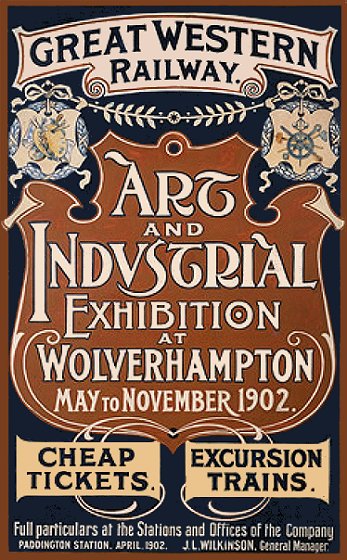 |
Building work on the large impressive
buildings started in 1901, after a competition was held for
the design. The winners were two Glasgow architects, Robert
Walker and Thomas Ramsey, who designed the three main
buildings; the Industrial Hall, the Machinery Hall, and the
Canadian Hall. The largest building, the Industrial Hall
was 107 metres long by 52 metres wide with three bays for
displays by British manufacturers. The slightly smaller
Machine Hall measured 107 metres long by 40 metres wide. It
also had three bays. The smallest of the three buildings,
the Canadian Hall, was paid for by the Canadian
Government and featured attractive displays about the
country, hopefully encouraging would-be immigrants from the
UK.
The two other major buildings were the
Concert Hall, and the Connaught Restaurant and Shell
Bandstand. The building contractors were James Herbert of
Hartley Street, and Henry Gough of Dudley Road. Smaller
buildings included the Barnard Popular Restaurant, several
small restaurants and tea rooms, and a number of small
structures built to house displays by local companies.
Amusements included the small kiosk bandstand, the water
chute, the spiral toboggan, the voyage through fairyland,
and magic mirrors. The buildings occupied the north eastern
corner of West Park and an area between Park Road East and
Newhampton Road East. A section of Park Road East was closed
to make way for the exhibition.
|
|
Because the local authority expected a
very large number of visitors to the exhibition, underground
toilets were built in Queen Square, and the council ensured
that the new electrically-powered trams would be up and
running between Whitmore Reans and the town centre to
provide easy access to the site.
The art displays in Wolverhampton Art
Gallery were planned by the Fine Art Committee, under the
chairmanship of Laurence Hodson. The committee consisted of
John Annan, John F. Beckett, Thomas B. Cope, Edward L.
Cullwick, Edward Deansley, A. C. C. Jahn (Director of the
art gallery), Charles Paulton Plant, J.P. (mayor of
Wolverhampton), H. G. Powell, W. S. Rowland, Thomas H.
Sidney, Ernest White, R. Williams, and Thomas Wilson.
The paintings and sketches included
works by John Constable, Sir Joshua Reynolds, William
Hogarth, Thomas Gainsborough, Van Dyck, J. M. W. Turner,
James Abbott McNeill Whistler, Horatio McCulloch, William
Strang, D. G. Rossetti, Rembrandt, Edward Burne Jones, and
many others.
|

An ornate light fitting on the front
of the Machinery Hall. From Hildreth & Chambers souvenir of
the exhibition. |
|
Many important artworks
were on display at the exhibition.
Duncan Nimmo has kindly sent the
following assessment of the art section,
that came from an article about William
Strang in the journal “Studio” from
1921.
Between 1899 and 1901 Strang painted the
ten canvasses with which he established
a place for himself amongst the English
painters of the day. This series, to be
mounted in panelling as a frieze, was
dedicated to the theme of Adam and Eve
and commissioned by an enlightened
collector and patron, the Wolverhampton
brewer, Laurence Hodson. It was in this
series that Strang first managed to
correlate a sympathetic code of
colouration with his established ability
to compose in the classic and massive
manner. Amongst those critics and
painters who felt that the decorative
and insubstantial aspects of French
Impressionism and bravura painting had,
via the N.E.A.C., gained too much of a
hold over young English artists, such
works were welcome.
The critic, Frank Rutter, later wrote
that ‘amongst the exhibitions of 1902, I
pick out as the most representative that
held in Wolverhampton. This I shall
always couple with the first
International Society as the two
exhibitions of modern art which have
most deeply stirred me, and while the
International thrilled me by its
Whistlers and its modern French
painting, it was at Wolverhampton that I
was first roused to consciousness that
there and now, all around me, was
growing up a really great school of
British painters . . . the sensational
feature of the exhibition was a room
devoted to the younger and intenser
artists of the day.’
Amongst these
artists, Wilson Steer, Tonks, Orpen,
Rothenstein, Nicholson, Holmes, Shannon
and John, he made specific mention of
Strang's Adam and Eve series. These were
noticeable also as amongst the very few
large scale religious and mural
paintings (always associated in the
English mind with attempted
nationalistic revivals of an indigenous
school of the date.) |
|
| The exhibits in the Industrial Hall
consisted of displays by British manufacturers, including
ironwork, safes, silverwork, glass, upholstery, paint,
bicycles, and even a display by Heinz, featuring soups,
baked beans, and tomato sauce, which visitors could sample. Other items on display included cycles by Beau Ideal, and Wulfruna; safes by Chubb, and George Price; locks and door
furniture by James Gibbons; fencing and gates by Bayliss,
Jones & Bayliss; and gears by John Roper. There were also
some exhibits from abroad including carvings from India, and
arts and crafts from Japan. |

One of the special stamps that
were produced to commemorate the exhibition.
Courtesy of Ralph Hickman. |

Another of the special
stamps that were produced to commemorate the
exhibition. Courtesy of Ralph Hickman. |
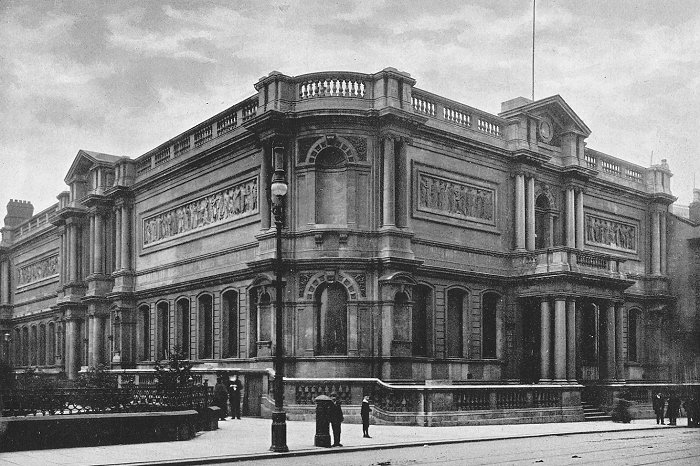
Wolverhampton Art Gallery where
the fine art section was on display. From H. J. Whitlock
& Sons photographic souvenir of the exhibition. |
|
In the Machinery Hall visitors could
see impressive displays of a wide range of machinery,
including motors, printing machines, weaving machines, and
the boilers and generators that were supplying the
electricity for the exhibition. Displays included electric
motors and generators by E.C.C.; boilers by John Thompson;
and pumps by Joseph Evans.
In the Canadian Hall were displays
featuring the country’s natural resources, including
minerals, gold ore, clay, timber, and agricultural goods
such as meat, fruit, whisky, butter, cheese, eggs, grain,
grasses, and canned goods. There were also displays of
photographs, and landscape paintings.
Entertainment in the Concert Hall
included orchestral concerts, recitals, and even a ping-pong
tournament. Outdoor entertainment included the five storey
spiral toboggan, the first of its kind in the country; the
water chute, the first one in the Midlands; the kiosk
bandstand, and a small fire station. There was also the
voyage through fairyland; and the magic mirror building with
its ‘hall of laughter’ with twenty five mirrors.
|

The fine wrought iron railings and
gates at the main entrance in Lansdowne Road. They were
manufactured by Bayliss, Jones & Bayliss Limited. From
Hildreth & Chambers souvenir of the exhibition. |
|
The exhibition opened on 1st May, 1902.
The president was the Earl of Dartmouth. The official
opening was carried out by the King’s brother, the Duke of
Connaught, who arrived at the High Level Station on a
special train along with a party of guests including the
Duchess of Connaught, and the mayor of London and his
sheriffs. They travelled to the exhibition after a brief
stop at Wolverhampton Art Gallery where they were greeted by
the mayor of Wolverhampton, Councillor Charles Paulton
Plant, before inspecting the fine art exhibits.
The carriage then made its way to the
industrial part of the exhibition via Queen Square, where
the new toilets were covered in red cloth to hide them from
the royal party’s view. They then proceeded via Darlington
Street, Waterloo Road, and Newhampton Road East. They
arrived at the exhibition and were welcomed in the Concert
Hall where speeches were given, and the exhibition was
declared open. At three o’clock they arrived at the
Industrial Hall where a gold key was handed to his highness,
who proceeded to unlock the front door. After viewing the
hall, the party visited the Canadian Hall where they were
received by Lord Strathcona, followed by an inspection of
the Machinery Hall, and a walk around the site. Around four
o’clock they entered the refreshment rooms for a rest before
returning to the railway station to catch their train. That
evening there were illuminations in the town and at the
exhibition.
|

The arrival of the Duke & Duchess
of Connaught. From H. J. Whitlock & Sons photographic
souvenir of the exhibition. |
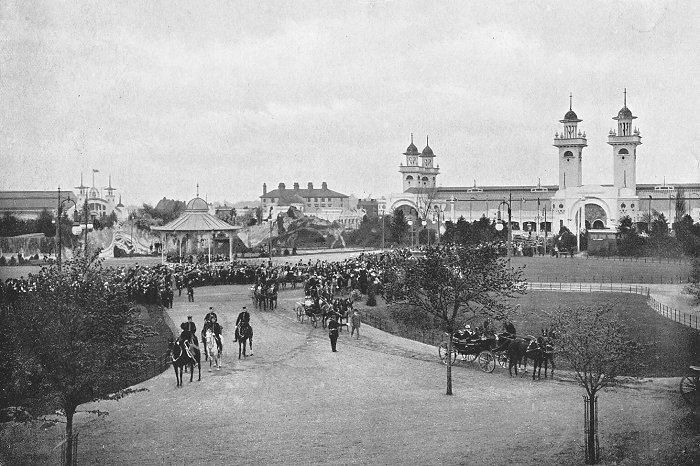
The arrival of the Duke & Duchess
of Connaught at the Concert Hall. From H. J. Whitlock &
Sons photographic souvenir of the exhibition. |
|

The opening ceremony. From H. J.
Whitlock & Sons photographic souvenir of the exhibition. |
| One local celebrity who visited the
exhibition was Colonel Tom Thorneycroft, the eccentric owner
of Tettenhall Towers. On seeing the great water chute, he
couldn’t resist having a go. The 81 year old was greatly
shaken by the buffeting during the descent, so much so that
he became ill. Sadly he never recovered, and died on 6th
February, 1903. |
|
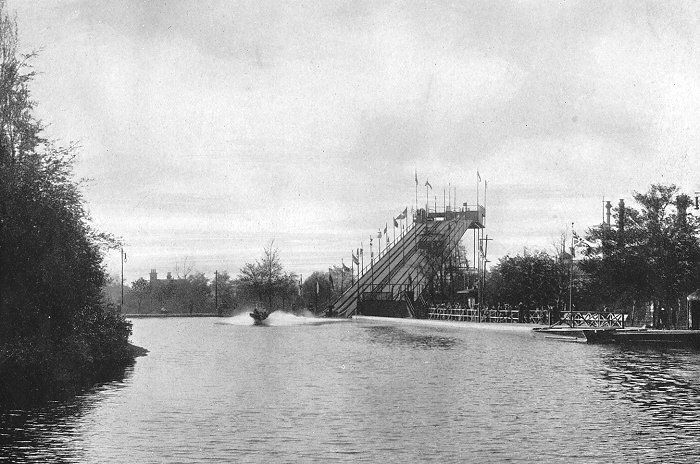
The water chute. From H. J.
Whitlock & Sons photographic souvenir of the exhibition. |
|
The exhibition, although
Wolverhampton’s grandest display, failed to attract the
expected number of visitors. One factor must have been the
poor summer, which was cool and unsettled. That year there
were three major volcanic eruptions, one at Martinique,
another at Guatemala, and a third in Mexico, which reduced
the solar radiation between 10 and 20 percent. Rail travel
was also quite expensive, so many people would have been
reluctant to travel a great distance to the event.
Although 245,000 people attended on the
first day, and around 1.5 million attended over a period of
six months, the exhibition made a loss of £30,000 which
equates to over £3 million in today’s money. By November the
subscribers had had enough. The exhibition closed on 8th
November, even though there were calls to reopen it in the
following year. It was a sad end to such a prestigious and
ambitious event, which initially attracted so much interest.
During the next few months everything
was sold at auction. Thomas J. Barnett & Sons, auctioneers,
produced a catalogue listing everything from the buildings
to their contents. By the end of 1903 the site must have
looked much the way it did before the exhibition was
planned. One of the sale items became the once well-known
Swiss chalet bus shelter in Wergs Road, Tettenhall, which
was eventually replaced by a modern structure.
|
|
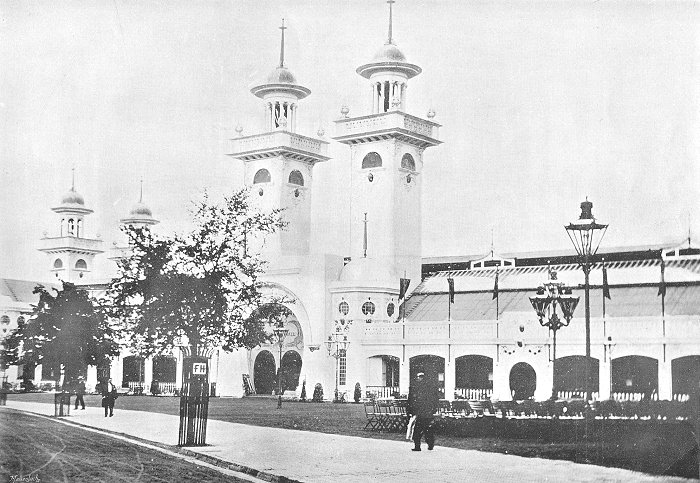
The Industrial Hall. From Hildreth
& Chambers souvenir of the exhibition. |
|
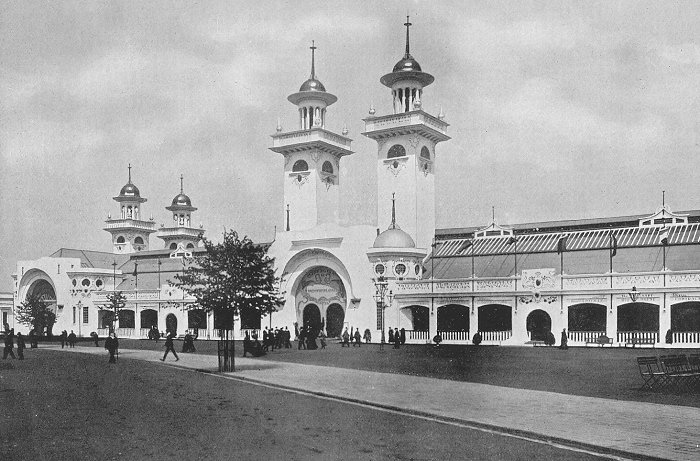
Another view of the Industrial
Hall. From H. J. Whitlock & Sons photographic souvenir
of the exhibition. |
|
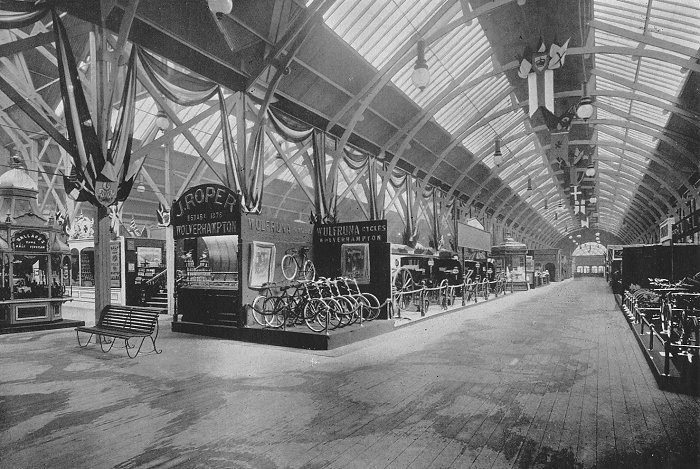
The interior of the Industrial
Hall. From H. J. Whitlock & Sons photographic souvenir
of the exhibition. The stand next to Wulfruna Cycles was
occupied by Charles Clark, carriage maker of Chapel Ash. |
|
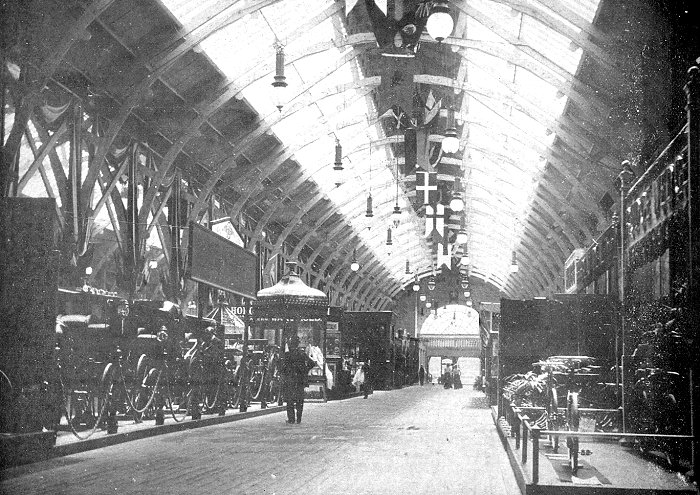
Another view of the interior of
the Industrial Hall. From Hildreth & Chambers souvenir
of the exhibition. |
|

The George Price display of safes
in the Industrial Hall. From Hildreth & Chambers
souvenir of the exhibition. |
|
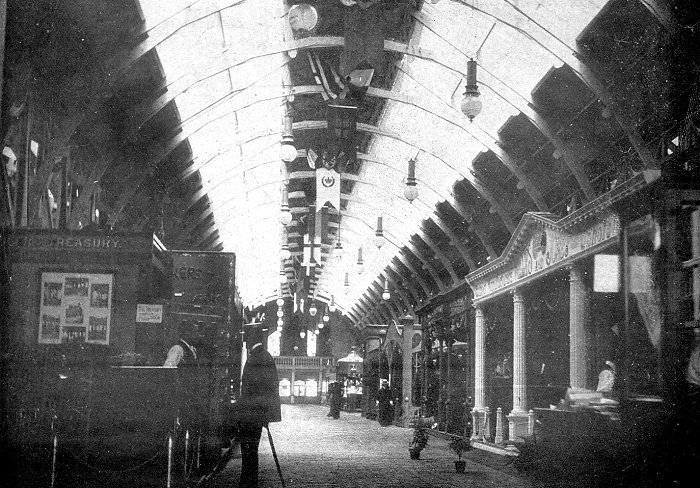
A final view of the interior of
the Industrial Hall. From Hildreth & Chambers souvenir
of the exhibition. |
|
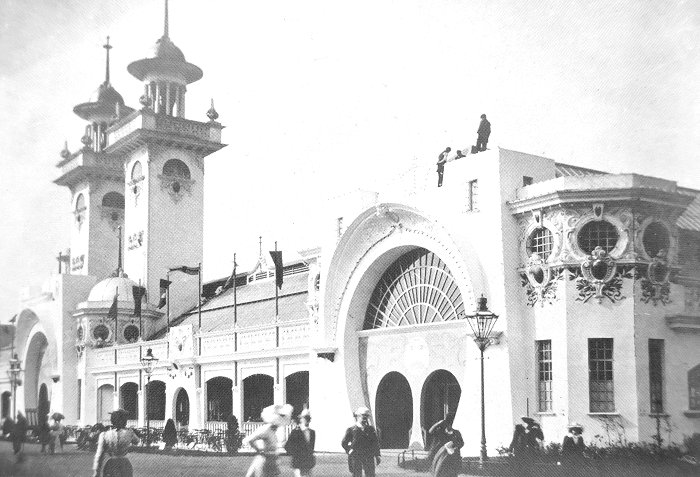
An external view of the
Industrial Hall, from an old postcard. Courtesy of
Craig Denston. |
|
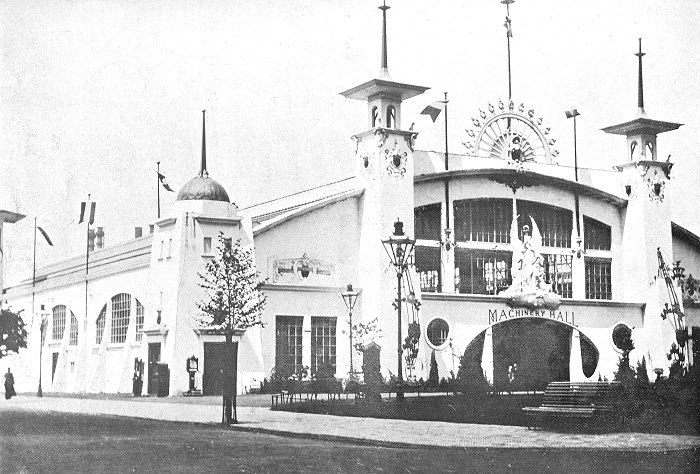
The Machinery Hall. From Hildreth
& Chambers souvenir of the exhibition. |
|
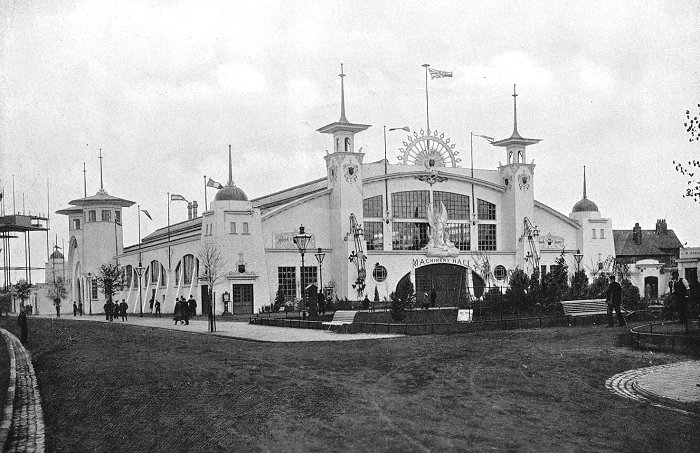
Another view of the Machinery
Hall. From H. J. Whitlock & Sons photographic
souvenir of the exhibition. |
|
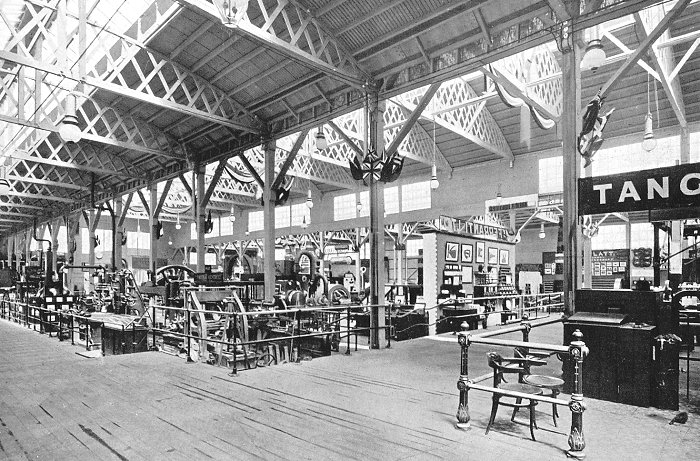
The interior of the Machinery
Hall. From H. J. Whitlock & Sons photographic souvenir
of the exhibition. |
|
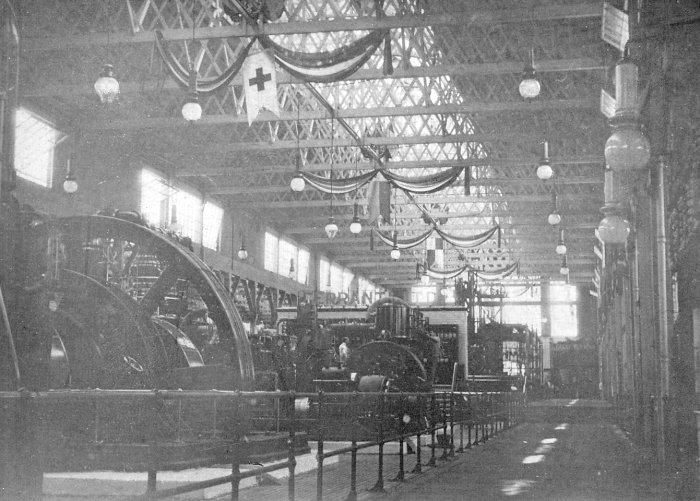
Another view of the interior of
the Machinery Hall. From Hildreth & Chambers souvenir of
the exhibition. |
|
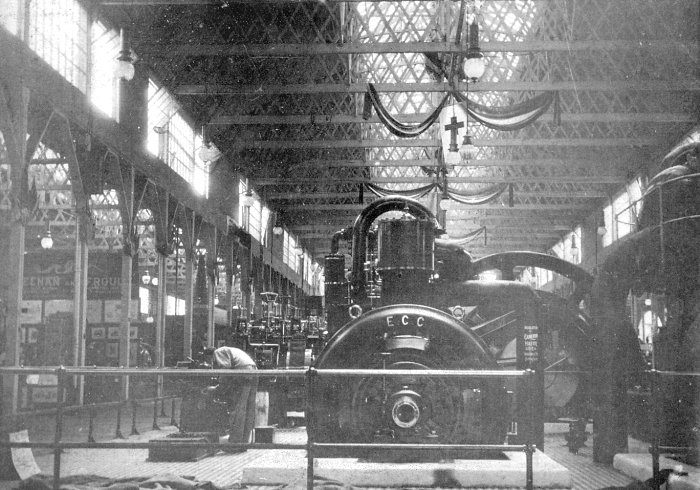
A final view of the interior of
the Machinery Hall. From Hildreth & Chambers souvenir of
the exhibition. |
|
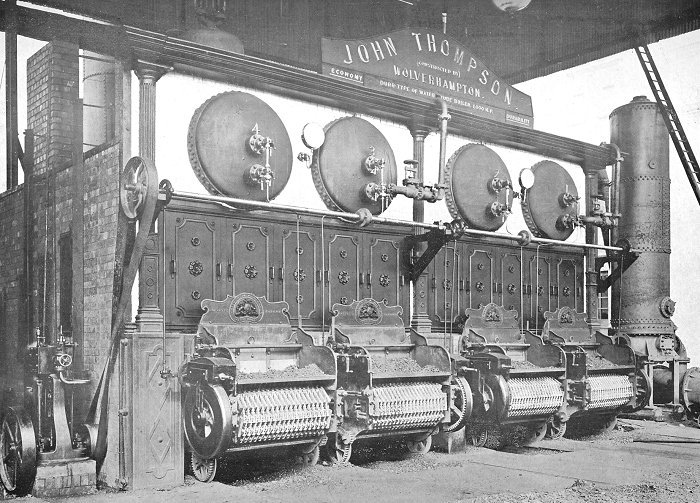
The John Thompson boilers in the
Boiler House. From Hildreth & Chambers souvenir of the
exhibition. |
|

The Canadian Hall. From H. J.
Whitlock & Sons photographic souvenir of the exhibition. |
|
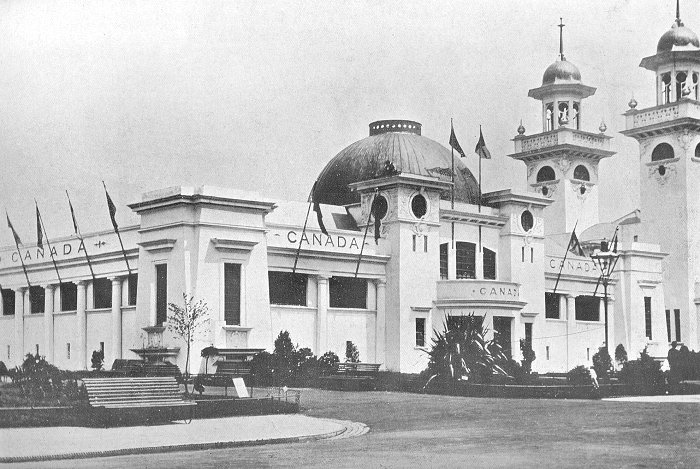
Another view of the Canadian Hall.
From Hildreth & Chambers souvenir of the exhibition. |
|
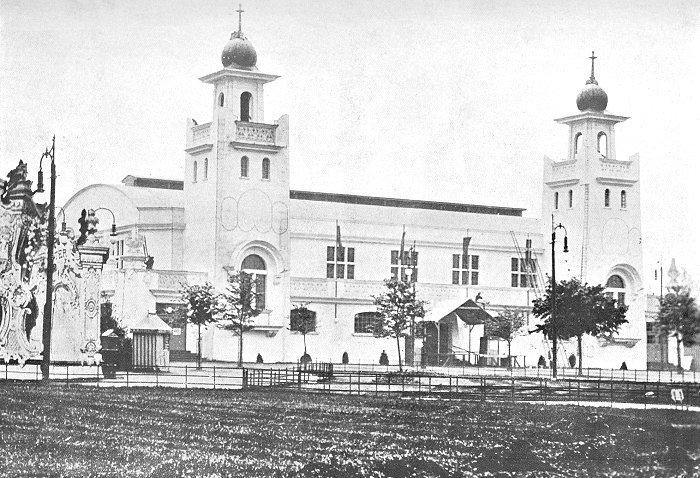
The Concert Hall. From Hildreth &
Chambers souvenir of the exhibition. |
|

Another view of the Concert Hall.
From H. J. Whitlock & Sons photographic souvenir of the
exhibition. |
|
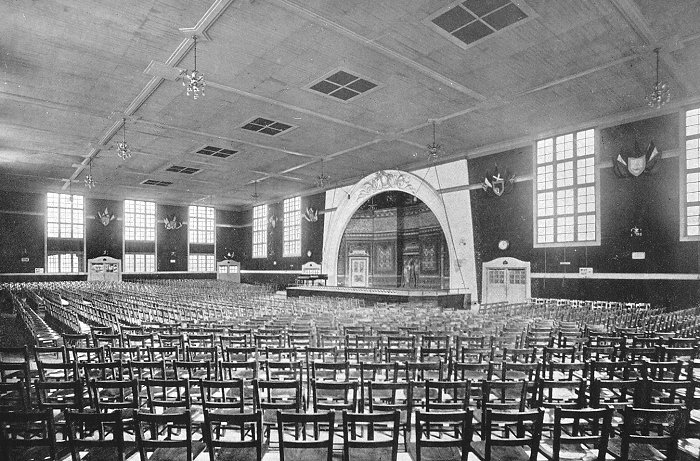
The interior of the Concert Hall.
From H. J. Whitlock & Sons photographic souvenir of the
exhibition. |
|
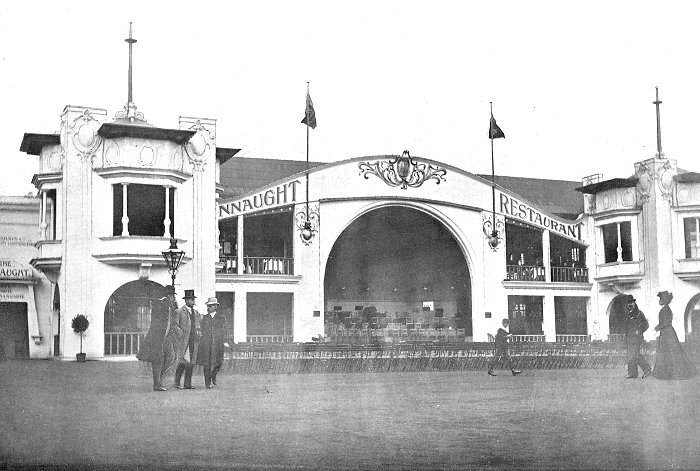
The Shell Bandstand and Connaught
Restaurant. From Hildreth & Chambers souvenir of the
exhibition. |
|
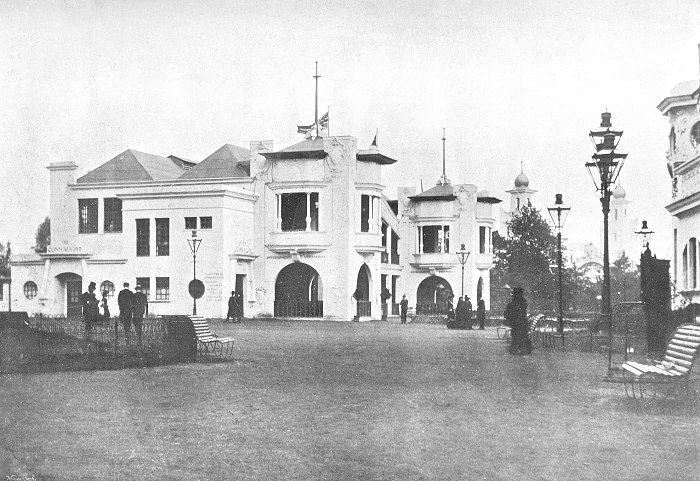
The Connaught Restaurant. From
Hildreth & Chambers souvenir of the exhibition. |
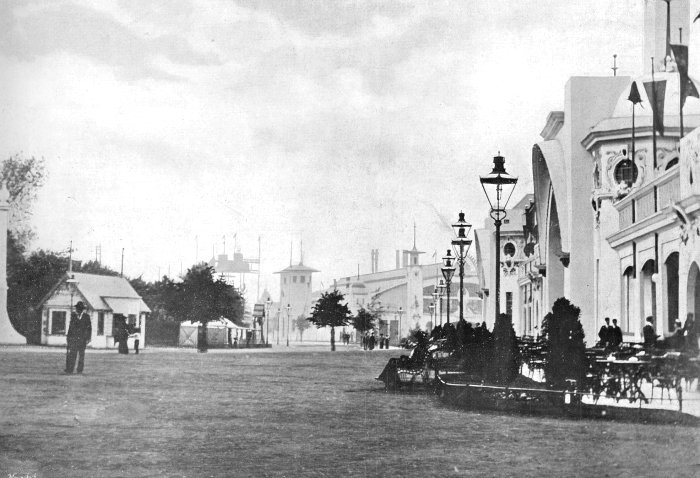
Looking towards the Machinery Hall
with the Industrial Hall on the right. From Hildreth &
Chambers souvenir of the exhibition. |
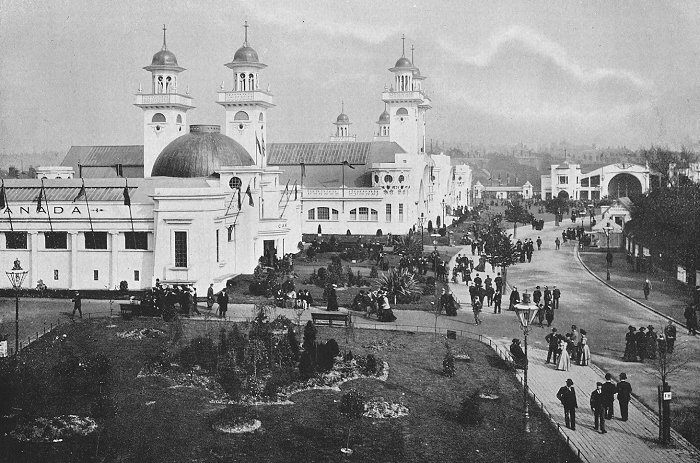
Looking eastwards towards the
Shell Bandstand and Connaught Restaurant. On the left is
the Canadian Hall with the Industrial Hall behind. From
H. J. Whitlock & Sons photographic souvenir of the
exhibition. |
|
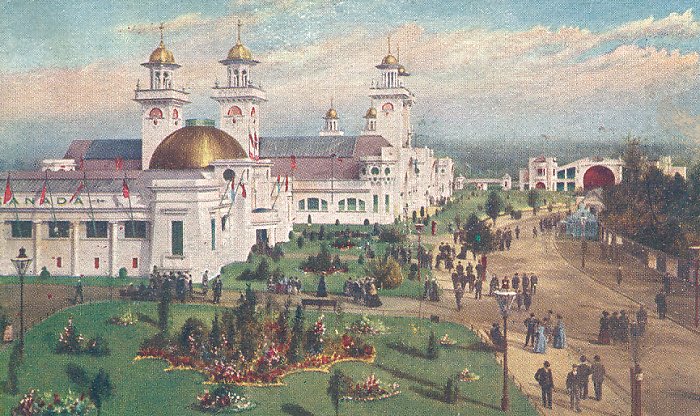
A hand-coloured version of the
previous image. From an old postcard. |
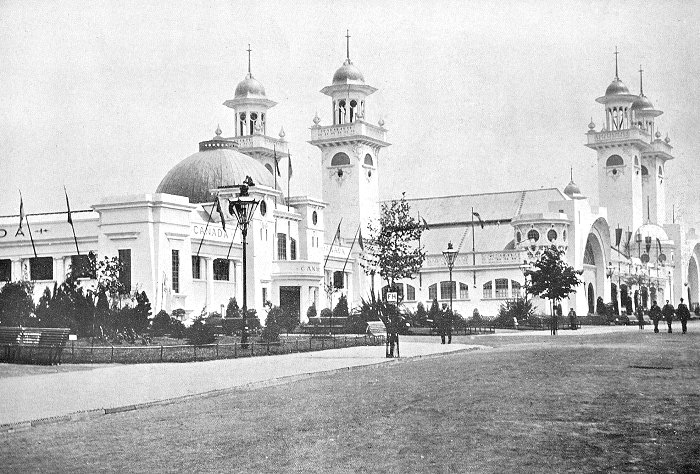
Another view looking east with the
Canadian Hall on the left and the Industrial Hall on the
right. From Hildreth & Chambers souvenir of the
exhibition. |
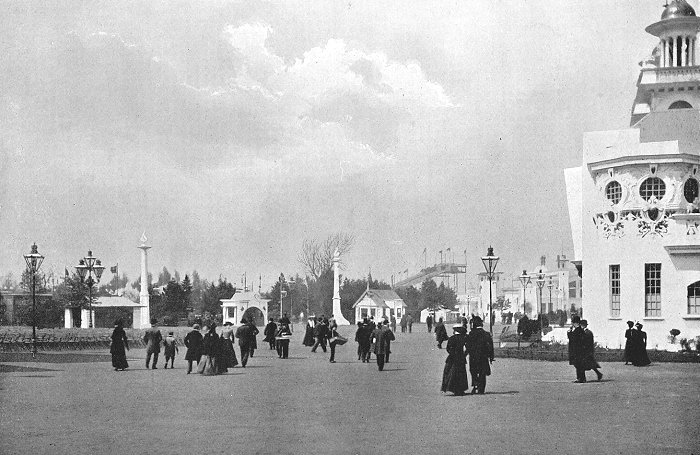
Looking westwards towards the
Water Chute from near the main entrance. From H. J.
Whitlock & Sons photographic souvenir of the exhibition. |
|
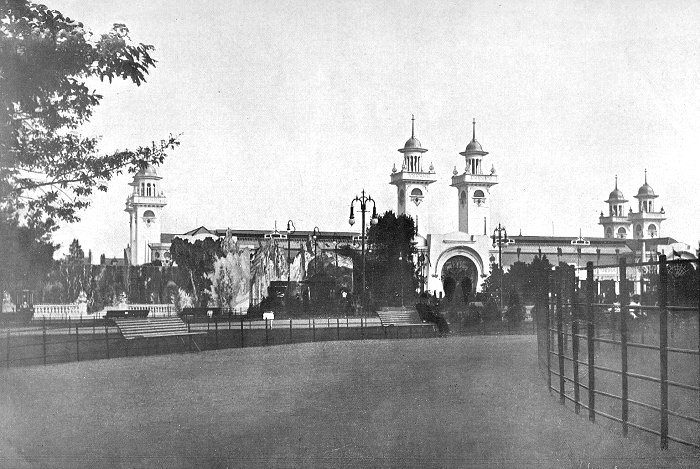
The Industrial Hall from West
Park. From Hildreth & Chambers souvenir of the
exhibition. |
|

The Barnard Popular Restaurant.
From Hildreth & Chambers souvenir of the exhibition. |
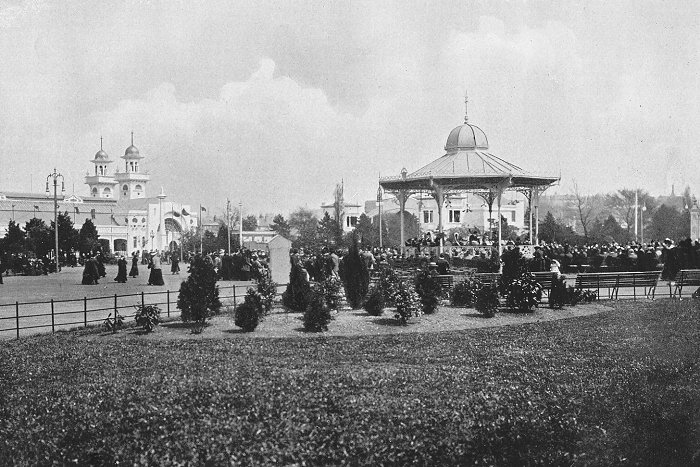
The Kiosk Bandstand with the
Industrial Hall on the left. From H. J. Whitlock & Sons
photographic souvenir of the exhibition. |
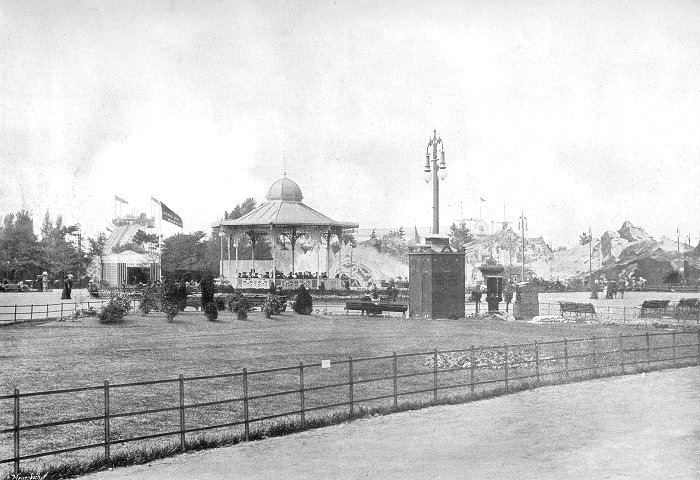
The Kiosk Bandstand with the Fire
Station to the left, and the Voyage Through Fairyland on
the right. From Hildreth & Chambers souvenir of the
exhibition. |
|

The Spiral Toboggan. From H. J.
Whitlock & Sons photographic souvenir of the exhibition. |
|
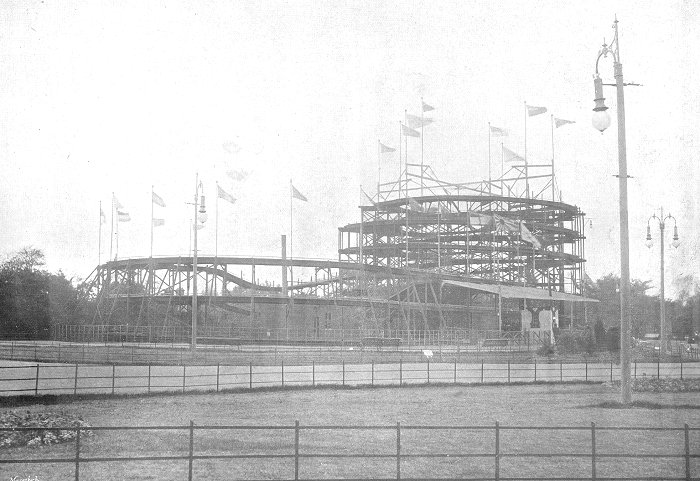
Another view of the Spiral
Toboggan. From Hildreth & Chambers souvenir of the
exhibition. |
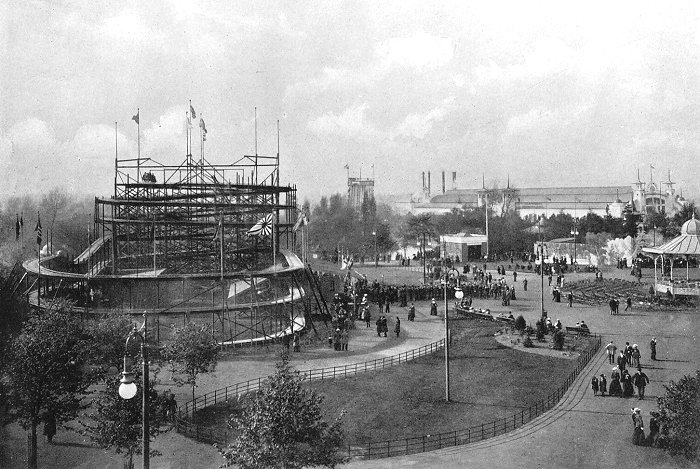
A final view of the Spiral
Toboggan with the Water Chute behind, and the Machinery
Hall in the distance on the right. From H. J. Whitlock &
Sons photographic souvenir of the exhibition. |
|
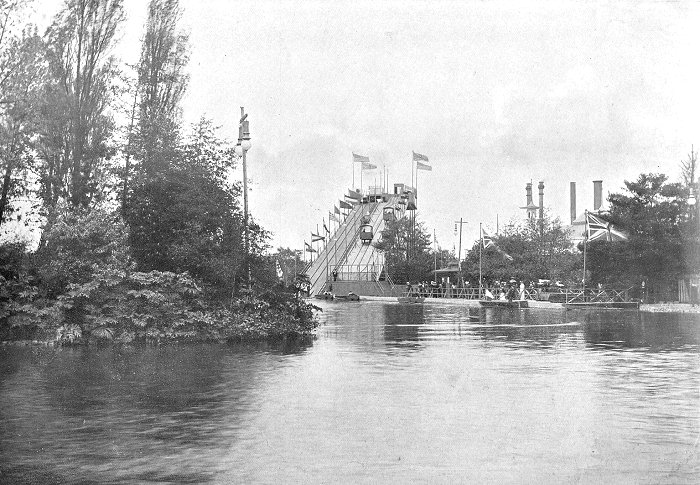
The Water Chute. From Hildreth &
Chambers souvenir of the exhibition. |
|
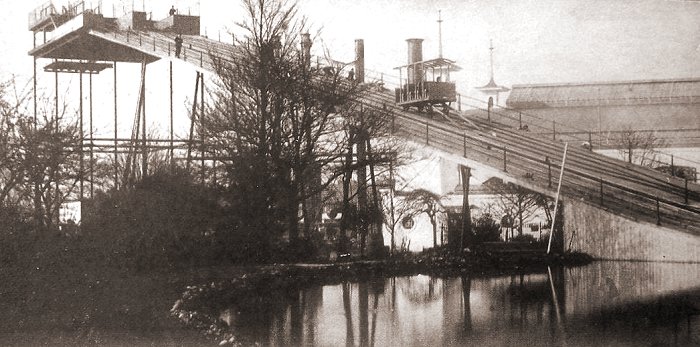
Another view of the water
chute. From an old postcard. |
|

A drawing of the water
chute by George Phoenix. |
|
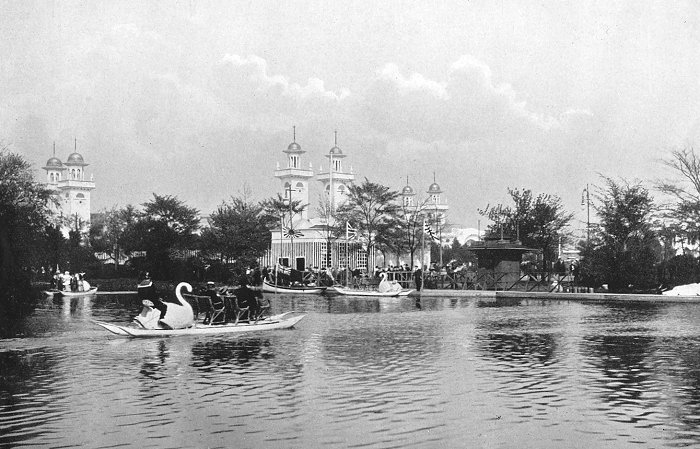
Swan boats on the lake. From H. J.
Whitlock & Sons photographic souvenir of the exhibition. |
|

An electric launch on the lake.
From Hildreth & Chambers souvenir of the exhibition. |
|
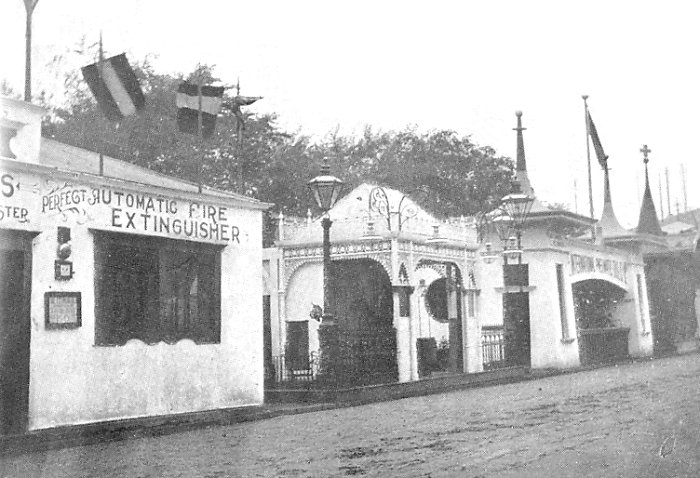
Some of the outside exhibits. From
Hildreth & Chambers souvenir of the exhibition. |
|

The Tournament and Firework
Ground. From Hildreth & Chambers souvenir of the
exhibition. |
|
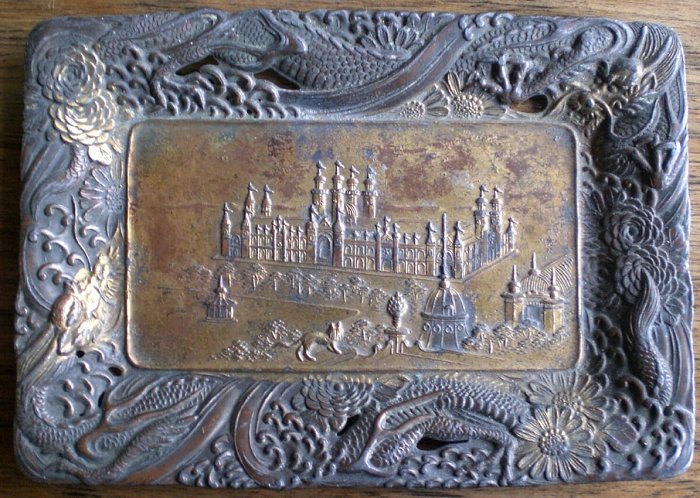
A commemorative ash tray.
Courtesy of David Parsons. |
|
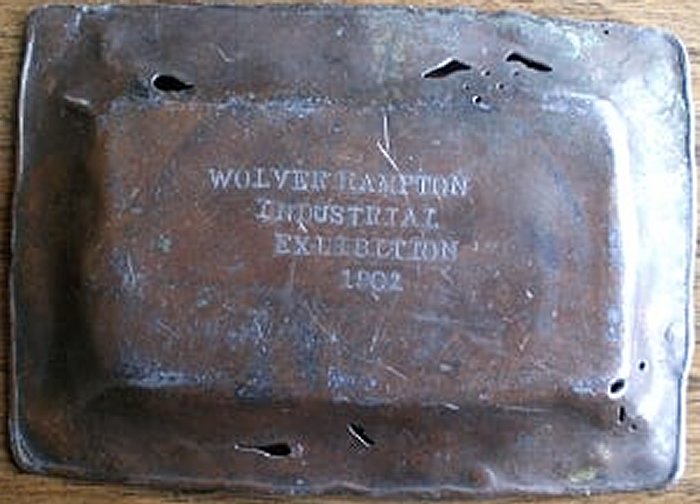
The underside of the ash tray.
Courtesy of David Parsons. |
 |
Return to
the
previous page |
|